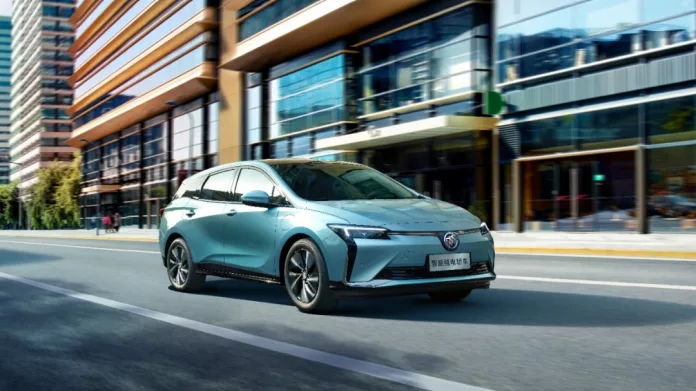In the fast-paced Chinese automotive market, plugins are taking center stage, with an impressive 743,000-unit sales bump in a 1.7-million-unit overall market—a robust 29% YoY increase. Of this, the boost in Battery Electric Vehicles (BEVs) notched up by 16%, and even more striking was the 62% leap in Plug-in Hybrid Electric Vehicles (PHEVs). With BEVs taking 64% of plugin sales, a slight dip from the yearly average of 67%, it’s evident that PHEVs are gaining substantial traction.
The cumulative total for the year edges towards 1.9 million units, concluding Q1 with a 36% YoY upturn. Plugin vehicles’ market share for March soared to 43%, with BEVs alone accounting for a compelling 28% of total auto sales in China. This progress hints that the market could soon break past the 50% plugin share threshold, potentially ending the first half of the year above 40%—a trendsetter for the broader automotive industry.
Top Performers in the Plugin Market
BYD Makes a Statement
Encouragingly, the top three best-sellers were all plugin vehicles, with BYD models leading, followed by the Tesla Model Y. Notably, ICE vehicles only managed to secure less than half of the top 10 positions, with the Nissan Sylphy at the forefront. BYD’s aggressive pricing strategies are making significant waves, pressuring not just their ICE counterparts, but their plugin competitors as well.
Foreign brands, traditionally dominant with ICE sales, are facing shrinking ground against local OEMs, which have grown their market share from 52% to 59% in just one year. As the electrification of the market gains pace, foreign OEMs are left grappling with just 15% of the plugin market share, highlighting a tectonic shift in the automotive landscape—a shift that could result in considerable market disruptions.
Electric Vehicle Best Sellers Breakdown
Battle of the Bestsellers: BYD Surges Ahead
BYD’s portfolio dominated last month’s sales, with the BYD Song leading the charge. The midsize SUV forged ahead with 62,622 registrations, cementing its position as a market leader. Despite growing internal competition and new models queuing for a slice of the pie, the Song has managed to defend its territory, much due to its recent price cuts.
Nipping at the Song’s heels was the BYD Qin Plus, another staple from BYD, which achieved an all-time high with 50,394 registrations in an increasingly competitive market. Meanwhile, the Tesla Model Y maintained its market presence with 47,917 registrations.
The hatchback market witnessed steady sales from the BYD Seagull, which pushed into the top 5, while the compact crossover space saw the BYD Yuan Plus re-enter the top 5 category, benefiting significantly from recent price adjustments. Competition is indeed fierce, with internal matchups and new launches shaping the EV landscape as we move forward.
Uncertain Future for Tesla’s Model 3 Refresh
While the bestsellers demonstrated strong growth, Tesla’s Model 3 faced a disappointing 25% YoY decline in the first quarter, despite market growth and a recent refresh. In an unexpected turn, the Model Y, which didn’t undergo a refresh, saw its sales inching upwards by 6%. This disparity has led Tesla to reconsider its strategy, postponing any refresh for the Model Y while reflecting on the Model 3’s lackluster performance—indicative of the intricacies of catering to the Chinese market.
Brand Dynamics in China’s EV Ecosystem
New Entrants and Spectacular Rises
In addition to the dominant BYD lineup, the top 20 featured a resurgence from the BYD Han and a record performance from the Destroyer 05. However, rivals suffered setbacks, including models like the AITO M7 and Li Auto‘s L7, hinting at the intimidating presence of BYD’s expansive strategy.
Interestingly, Buick found success with its Velite 6 model, a rare compact station wagon making inroads in the Chinese market, which raises questions about potential acceptance in the US market.
Finally, newcomers like the Xiaomi SU7 are poised to disrupt the market with an enticing value proposition, boasting features comparable to luxury models but at significantly lower prices. With orders rather than mere reservations stacking up impressively, Xiaomi is set to become a new force in the automotive sector.
BYD’s Dominance and OEMs’ Tussle for Market Share
March’s brand ranking saw BYD fortify its lead, but established players like Volkswagen and Toyota experienced minor setbacks. Geely made headway with a 24% growth rate, signaling a positive trend amidst overall market adjustments. Closer examination reveals the ebbs and flows of market shares among major brands and OEMs, as they navigate through the dynamic environment shaped by aggressive pricing and innovative product launches.
In conclusion, China’s electric vehicle market is in the throes of a remarkable shift, with BYD leading the charge and traditional automotive powerhouses striving to adapt. The continuous surge in plugins, alongside strategic pricing and the launch of compelling new models, maps a fascinating trajectory for the world’s largest auto market. With various brands rising and others re-evaluating their offerings, the market landscape promises a dynamic and competitive future.
























